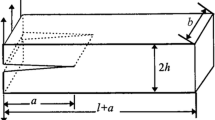Abstract
Experimental results have shown that composite cantilever beams with ultra high molecular-weight polyethylene fibres are collapsed by a new mode of microbuckling, which involves elastic bending and shearing of the plies, and plastic shear of the interfaces. Different finite element modelling strategies were employed in this study. Simulation results reveal that an enough number of interfacial cohesive layers, accurate partition of the shear stiffness between plies and interfaces, and accurate partition of the flexural stiffness between plies are important in predicting the collapse responses. The sensitivity of the predicted microbuckling responses to the overall effective shear modulus and interlaminar shear strength of long composite beams are also investigated.
Similar content being viewed by others
References
Dolez P.I., Vu-Khanh T.: Recent developments and needs in materials used for personal protective equipment and their testing. Int. J. Occup. Saf. Ergon. 15, 347–362 (2009)
Smith P., Lemstra P.J., Kalb B., Pennings A.J.: Ultrahigh-strength polyethylene filaments by solution spinning and hot drawing. Polym. Bull. 1, 733–736 (1979)
Smith P., Lemstra P.J.: Ultra-high-strength polyethylene filaments by solution spinning/drawing. J. Mater. Sci. 15, 505–514 (1980)
Tan V.B.C., Shim V.P.W., Tay T.E.: Experimental and numerical study of the response of flexible laminates to impact loading. Int. J. Solids Struct. 40, 6245–6266 (2003)
Tan V.B.C., Khoo K.J.L.: Perforation of flexible laminates by projectiles of different geometry. Int. J. Impact Eng. 31, 793–810 (2006)
Greenhalgh E.S., Bloodworth V.M., Iannucci L., Pope D.: Fractographic observations on Dyneema\({^{\circledR}}\) composites under ballistic impact. Compos. Part A Appl. Sci. Manuf. 44, 51–62 (2013)
Karthikeyan K., Russell B.P., Fleck N.A., O’Masta M., Wadley H.N.G., Deshpande V.S.: The soft impact response of composite laminate beams. Int. J. Impact Eng. 60, 24–36 (2013)
Karthikeyan K., Russell B.P., Fleck N.A., Wadley H.N.G., Deshpande V.S.: The effect of shear strength on the ballistic response of laminated composite plates. Eur. J. Mech. A Solids. 4, 35–53 (2013)
Ong C.W., Boey C.W., Hixson R.S., Sinibaldi J.O.: Advanced layered personal armor. Int. J. Impact Eng. 38, 369–383 (2011)
Grujicic M., Glomski P.S., He T., Arakere G., Bell W.C., Cheeseman B.A.: Material modeling and ballistic-resistance analysis of armor-grade composites reinforced with high-performance fibers. J. Mater. Eng. Perform. 18, 1169–1182 (2009)
Frissen, R., Peijs, T., Verlinde, A.: Modelling the ballistic impact behaviour of high-performance polyethylene fibre reinforced laminates. 16th International Symposium on Ballistics, San Francisco, USA (1996)
Iannucci L., Pope D.: High velocity impact and armour design. Express Polym. Lett. 5, 262–272 (2011)
Utomo B.D.H., Ernst L.J.: Detailed modelling of projectile impact on dyneema composite using dynamic properties. J. Solid Mech. Mater. Eng. 2, 707–717 (2008)
Hazell P.J., Appleby-Thomas G.J., Trinquant X., Chapman D.J.: In-fiber shock propagation in Dyneema\({^{\circledR}}\). J. Appl. Phys. 110, 043504 (2011)
Czechowski L., Jankowski J., Kubiak T.: Experimental tests of a property of composite material assigned for ballistic products. Fibers Text. East. Eur. 3, 61–66 (2012)
Marissen R.: Design with ultra strong polyethylene fibers. Mater. Sci. Appl. 2, 319–330 (2011)
Liu G., Thouless M.D., Deshpande V.S., Fleck N.A.: Collapse of a composite beam made from ultra high molecular-weight polyethylene fibres. J. Mech. Phys. Solids. 63, 320–335 (2014)
McCrum N.G., Buckley C.P., Bucknall C.B.: Principles of Polymer Engineering. Oxford Science Publications, Oxford (2003)
Tang S., Greene M.S., Liu W.K.: Two-scale mechanism-based theory of nonlinear viscoelasticity. J. Mech. Phys. Solids. 60, 199–226 (2012)
Russell B.P., Karthikeyan K., Deshpande V.S., Fleck N.A.: The high strain rate response of ultra high molecular-weight polyethylene: from fibre to laminate. Int. J. Impact Eng. 60, 1–9 (2013)
Author information
Authors and Affiliations
Corresponding author
Rights and permissions
About this article
Cite this article
Liu, G. Modelling microbuckling failure of a composite cantilever beam made from ultra high molecular-weight polyethylene fibres. Acta Mech 226, 1255–1266 (2015). https://doi.org/10.1007/s00707-014-1247-5
Received:
Revised:
Published:
Issue Date:
DOI: https://doi.org/10.1007/s00707-014-1247-5




